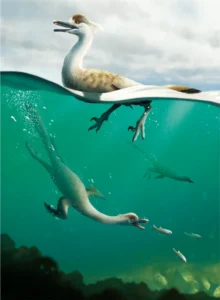
Scientists have discovered a new species of a swimming, hunting dinosaur from the Gobi Desert, Mongolia.
The Gobi Desert of Mongolia has been a source of non-avian dinosaurs for a long time. Recently, a team of scientists unearthed a well-preserved skeleton of a new Theropod (a bird-like dinosaur) Natovenator polydontus gen. et sp. nov. from the Baruungoyot Formation at Hermiin Tsav in the southern Mongolian Gobi Desert.
The preserved skeleton of the new dinosaur species shows that it had a dorsoventrally flattened and streamlined body signifying that Natovenator polydontus was capable of swimming.
This is for the first time a non-avian dinosaur with swimming capabilities has been discovered.
Interesting to note is the presence of numerous small, tightly packed teeth (presumably to hunt fish) and large replacement teeth in each jaw of the skull, which looks like a bird skull. The skull sits on top of a long neck made of 10 cervical vertebrae.
Based on the studies of the rib structures of this species it was concluded that it might have been a semi-aquatic animal and ecologically similar to the Plesiosaurs, and the Spinosaurs.
The species was named based on its major characters which say that it is a swimming hunter with many teeth (Natovenator: nato (swim) and venator (hunter) from Latin; and polydontus: from Greek polys (many) and odous (tooth) referring to the presence of numerous teeth).
This well-preserved specimen was discovered and extracted by Philip J. Currie, and Robin Sissons of the Department of Biological Sciences, University of Alberta, Edmonton, AB, Canada, in a team led by Yuong-Nam Lee of School of Earth and Environmental Sciences, Seoul National University, Seoul, Korea.
You can read more about this interesting discovery which was published on 1st December 2022 in Communications biology